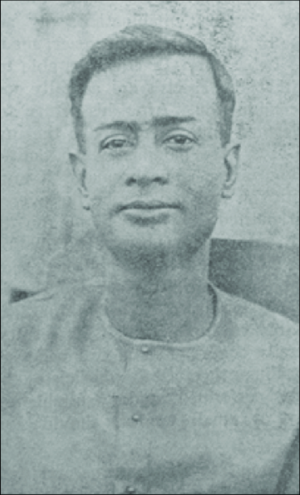Bidhu Bhushan Ray facts for kids
Quick facts for kids
Bidhu Bhushan Ray
|
|
|---|---|
 |
|
| Born | 1 July 1894 Khadarpara, British India
|
| Died | 29 July 1944 (aged 50) |
| Nationality | Indian |
| Alma mater | Rajabazar Science College Calcutta University |
| Known for | X-ray spectroscopy; scattering of light |
| Scientific career | |
| Fields | Physics |
| Institutions | Rajabazar Science College Calcutta University |
| Doctoral advisor | C. V. Raman |
Bidhu Bhushan Ray was an important Indian physicist. He was a leader in the study of X-ray spectroscopy. His laboratory was the first of its kind in India. He also studied how light scatters in the air. This work helped us understand things like rainbows and colorful clouds.
Bidhu Bhushan Ray helped connect Indian scientists with scientists in Europe. He was a Fellow of the Indian National Science Academy. He was also a special professor of Physics at the Rajabazar Science College, which is part of the University of Calcutta. He held this job until he passed away.
Contents
Early Life and Studies
Bidhu Bhushan Ray was born on July 1, 1894. His birthplace was Khadarpara, in what was then British India. Today, this area is part of Bangladesh. He finished his education in Calcutta, India.
He earned his D.Sc. degree in 1922. His main research was about how light scatters in the atmosphere. He worked under the famous scientist C. V. Raman. As part of his studies, he explained how glories, coronas, and iridescent clouds form. These are beautiful light effects you can see in the sky.
His Career in Science
In 1921, Bidhu Bhushan Ray became a physics lecturer. He taught at the University College of Science and Technology in University of Calcutta. He worked there for the rest of his life.
In 1923, he took a two-year break to travel to Europe. He spent some months in Uppsala, working with Manne Siegbahn. There, he began his experiments with X-ray spectroscopy. This is a way to study materials using X-rays.
Next, he moved to Copenhagen to work with Niels Bohr. Bohr was a very famous physicist. Ray spent over a year there, doing important theoretical work on X-ray spectra. After Copenhagen, he visited other labs in Germany and Italy. Then, he returned to India.
Ray was inspired by his time in Europe. He decided to create a special lab for X-ray spectroscopy in Calcutta. This would be the first lab of its kind in all of India. It was hard to get money from the University of Calcutta. But Niels Bohr wrote letters to the university. He told them how skilled Ray was and why the lab was important.
Finally, Ray opened his research lab in 1927–28. For the next fifteen years, he published many research papers. These papers appeared in top science journals. Besides X-ray work, he also continued his studies on weather. His lab became a place where young physicists learned and trained. For example, R. C. Majumdar studied there. In 1935, Ray became the Khaira Professor of Physics. This was a very respected position.
Later Life and Passing
Bidhu Bhushan Ray passed away on July 29, 1944. He had a heart attack. This happened less than a month after his 50th birthday.
Some people thought a difficult situation at his lab might have caused his death. However, a researcher named Rajinder Singh studied old documents. He believes this story is not likely true. Singh noted that Ray had been sick with malaria and other health problems. These might have led to his early death.
Other Important Work
Besides teaching and research, Ray also wanted to share science with more people. He helped start the Indian Science News Association in 1935. He was also its Secretary. He edited its magazine, called Science and Culture. This magazine helped spread new scientific ideas.
Awards and Recognitions
Bidhu Bhushan Ray received several honors for his work:
- He was chosen as a Fellow of the National Institute of Science of India in 1935. This group is now called the Indian National Science Academy.
- He became the Khaira Professor of Physics at the University of Calcutta in 1935.
- He was elected President of the Physics Section of the Indian Science Congress in 1942.
His Legacy
After C. V. Raman, B.B. Ray was one of the first Indian physicists to create a research lab. This lab produced important results that were published in famous journals like Nature. This really helped experimental physics grow in India.
Even though Ray was recognized during his life, he was almost forgotten for many years. But recently, people have become interested in his work again. Rajinder Singh, who wrote a book about Ray, calls him "an unsung hero in Indian science." Singh also says that Ray's connections with European scientists were very important. They helped other Indian scientists, like S. N. Bose and M. N. Saha, connect with scientists abroad too.
The Indian Science News Association is still active today. It continues to publish the Science and Culture magazine.

